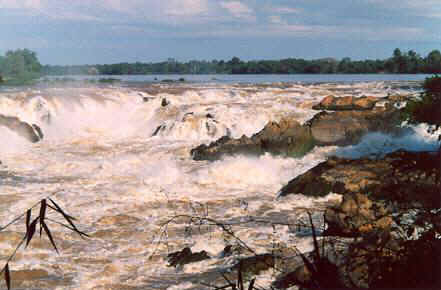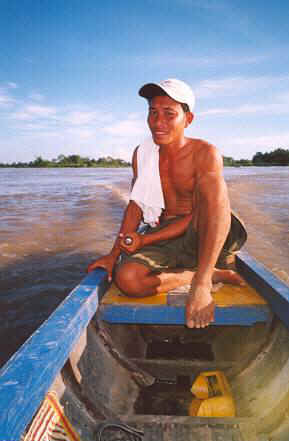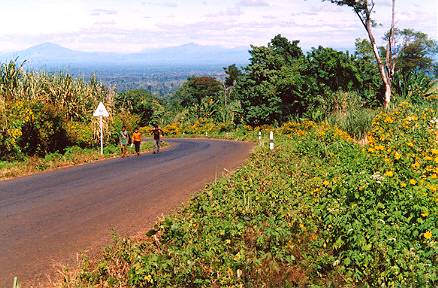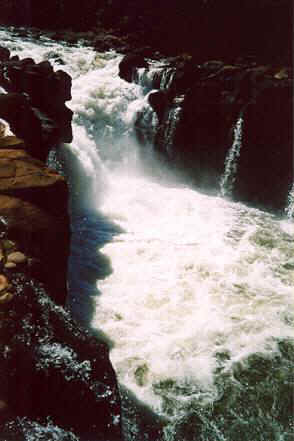SOUTHERN LAOS
Bill and Bessie Too puff and pedal into Laos
Pakse, People's Democratic Republic
of Laos
2 December 2002—Lao National Day
Has a government employee ever asked you for "overtime"? Well, today
being a national holiday, the Lao immigration fellow demanded 80 Thai Baht ($2)
as an extra fee. Welcome To Laos!
Lao National Day commemorates the communist victory over the pro-western monarchist
forces in 1975. Probably not an event that's celebrated in the Pentagon! The Lao
government has been described as a pragmatic socialist system, and is closely patterned
after Vietnam's.
The last few days in Thailand had some enjoyable stops. Before pedaling out of
Ubon Ratchathani, I rode north to visit Wat Phra That Nong Bua, which features a
replica of the Mahabodhi stupa in Bodhgaya, India. The exterior has elaborate reliefs
of the Buddha's past lives, along with many Buddha statues and mythical figures.
A smaller stupa and more Buddha statues stand inside. Nearer downtown, 150-year-old
Wat Thung Si Meuang has a beautiful traditional library with a multi-tiered roof;
the building stands on stilts over a pond to protect it from wandering insects.
A worship hall has some wonderful old paintings of Thai life.
From Ubon, we wandered east to the Mekong River and visited some groups of prehistoric
paintings, 1000-3000 years old, at Pha Taem National Park. Today we headed south
through rolling forested hills to the market town of Chong Mek, then crossed into
Laos P.D.R. Only mad water buffaloes and cyclists were out in the hot mid-day sun.
I nearly melted in the heat except for the cooling breeze from cycling and my insulated
helmet. A Lao-Nippon bridge spans the immense brown waters of the Mekong, just before
the regional capital of Pakse. Giant billowing clouds finally let loose a rainstorm
after we had settled into a hotel.
I couldn't resist asking for an air-conditioned room. The price, however, was
70,000 kip! I peeled off the 5,000-kip bills until reaching the vast sum, actually
just US$7. Yes, if you'd like to be a quick-and-easy millionaire, come to Laos and
change US$100! You'll get a thick stack of two hundred 5,000-kip notes (the biggest
the bank had).
I'll take a rest day tomorrow, visit the museum, and walk around town. Next,
a few hours to the south and a ferry ride across the Mekong, is Wat Phu Champasak,
a major Khmer temple site. A long ride farther south will take us to Si Phan Don
(Four Thousand Islands) for some island life in the Mekong near the Cambodian border.
Bill and Bessie Too have a hot time in the far south of Laos
Savannakhet,
Laos
17 December 2002
We've been wheeling along in Laos for two weeks now—the days have just whizzed
by!
From Pakse, we first headed south 30 km, ferried across the Mekong River, cooled
off over lunch at a riverside restaurant in Champasak town, then continued to the
Khmer site of Wat Phu Champasak. Unlike the meticulously restored Phanom Rung site
that we visited in Thailand, this one has a very atmospheric tumbled-down appearance.
From a huge pond, a promenade flanked by stone lotus bud columns (most lying on
the ground) leads to a pair of large rectangular worship pavilions, the most impressive
buildings here due to their size and detailed carvings. The pathway continues west
past a Nandi pavilion, now empty, and climbs past some guardian figures and a Ganesha
to the main sanctuary. This structure of stone blocks has many detailed carvings
of Hindu epics and gods. Originally it housed a Shiva lingam continually bathed
in water from a nearby spring. Now it shelters several folksy Buddhas.
Yes, it was hot and humid. The calendar may have said "December," but
the sun wasn't thinking of taking a rest. The next day we moseyed south, with many
drink and shade stops, to Si Phan Don—"Four Thousand Islands." The
Mekong, 4350 km from its source in the Tibetan Plateau, had spread out to a width
of 14 km with many islands. Our destination for the day was the largest island,
Don Khong ("Island Mekong" in Lao). Crowds had gathered in the main town
of Muang Khong for the carnival and boat races. Six long canoes (like in Hawaii
Five-O, but no outriggers.) and two shorter canoes came out for the final events.
Boatmen paddled furiously in perfect synchronization along a one-km course in the
river. The excitement peaked for the final run when all eight boats speeded along
toward the finish line.
Next day, we pedaled south almost to the Cambodian border and stopped at an overlook
of Khon Papheng Falls. Here the mighty Mekong plunged in a fierce cascade of mist
and foam. This wasn't good for boat navigation, but back around the early 20th century,
the French had built piers and a 14-km railway on the nearby islands of Don Khon
and Don Det. We went over in a motorized canoe past lush green islets well above
the falls. The islands were the sort of palm-fringed places where travelers would
laze the days away swinging in a hammock and sipping cool fruit shakes. Life was
simple—no cars, no electricity, no telephones, no alarm clocks. We visited
another section of the falls on the west side of Don Khon, here just a set of rapids
among dense foliage, then bumped our way south on the railroad bed to the enormous
concrete pier where goods and even whole boats were once hoisted onto the trains.
Pieces of a locomotive rusted nearby. WWII bombing by the Japanese had put a permanent
end to the train ride.
The next morning, change was in the air—literally. A cool breeze now came
out of the northeast, which, although a headwind for the long ride north, felt good.
After an overnight at Champasak, I pedaled north and east to the hills of the Bolaven
Plateau. Each day of our three-day loop on the plateau had a different waterfall.
The first was the best—a twin cascade of 120 meters fell into the head of a
verdant canyon. Roadside vegetation ran riot with tall weeds decked in yellow or
blue flowers.
Back in Pakse, we continued north on Hwy. 13, a smooth paved road with little
traffic. Lots of friendly kids calling out "Sabai Dee" or "Hello."
The scenery alternated between villages and forest—not exciting, but pleasant
enough.
Savannakhet has a crumbling charm; old French colonial architecture surrounds
a neglected plaza. The solid St. Teresa Catholic Church stands at one end, and the
Internet cafe I'm using at the other. A block farther west the Mekong glides gently
southward. The Thai town of Mukdahan lines the other shore.
Life in Laos has many similarities to Thailand—food and language have much
in common—but the Laotians are keen to preserve their identity despite the
presence of vigorous economies in neighboring Thailand and Vietnam. The Lao like
their laid-back lifestyle! One odd aspect of Laos is the scarcity of newspapers
and the even rarer sight of someone reading one! The government has no need of criticism,
so there's no reason to have a free press. There is Thai television, though, which
most Laotians watch; even little bamboo shacks in the rural areas commonly sport
a TV antenna pointed toward Thailand.
 North
Worship Pavilion of Wat Phu Champasak.
North
Worship Pavilion of Wat Phu Champasak.
The site has two worship pavilions flanking
the path to the main temple.
The Khmers may have started construction of the sandstone
buildings as
early as the 6th century and continued work as late as the 13th.

Showing its age, the main temple stands on the highest level
A Buddha statue
swathed in yellow sits unperturbed nearby.

Racers dig into the Mekong with their paddles in the boat racing festival on
Don Khong, the largest island of the Si Phan Don ("Four Thousand Islands").
An official and policeman monitor the race from the motorized canoe in the foreground.

Lao musicians and an enthusiastic crowd cheer on the boatmen.

Farther downstream, the Mekong roars over Khon Phapheng Falls.
The drop is only
about 10 meters, but the water volume is huge.
Cambodia lies just a short distance
farther downriver.

A canoe takes shape on idyllic Don Khon.
Rapids of the Mekong rush by the beach
here.

Our boat taxi weaves through Si Phan Don
archipelago as we leave Don Khon.
 Two
days later we climbed up onto the Bolaven Plateau
Two
days later we climbed up onto the Bolaven Plateau
and saw Tat Fan, twin waterfalls
plunging 120 meters into the head of a canyon.

Yellow flowers and thick vegetation line the roads on the Bolaven Plateau.

Whitewater plunges over black basalt at
Phasoume Waterfall on the Bolaven Plateau.

The sleepy plaza lined with French colonial buildings in Savannakhet.
On to Central Laos and Vientiane
 North
Worship Pavilion of Wat Phu Champasak.
North
Worship Pavilion of Wat Phu Champasak.





 Two
days later we climbed up onto the Bolaven Plateau
Two
days later we climbed up onto the Bolaven Plateau

